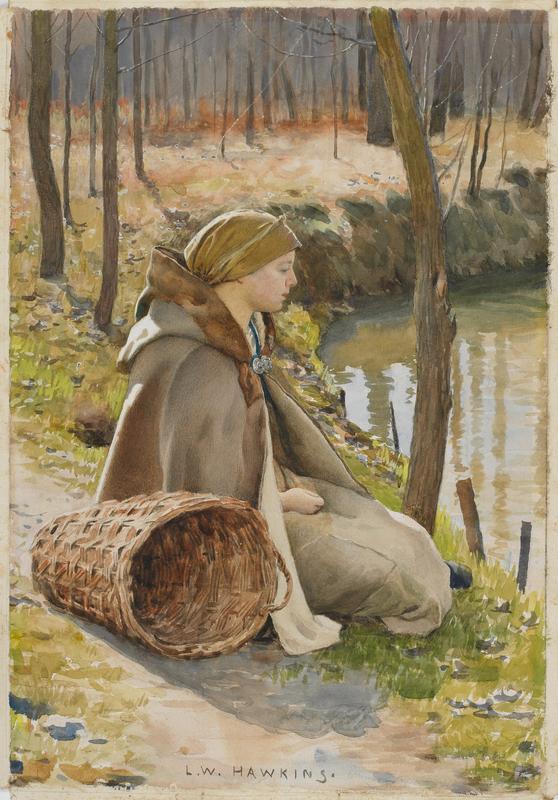
84. Louis Welden Hawkins, Reverie (also called Young Shepherdess Seated near a River)
| Artist | Louis Welden Hawkins, French (born Germany), Esslingen, Baden-Württemberg, Germany 1849–Paris 1910 |
| Title, Date | Reverie (also called Young Shepherdess Seated near a River), before 1884 |
| Medium | Watercolor over graphite |
| Dimensions | 17 5/8 × 12 in. (44.8 × 30.5 cm) |
| Inscriptions + Marks | Lower center: L.W. HAWKINS |
| Provenance | Collections de feu M. Borniche, Catalogue des tableaux modernes, dessins et aquarelles, troisième vente, Hôtel Drouot, Paris, January 10–11, 1884, no. 197; to Guincêtre for 200 francs. [Clignancourt market, Paris, until 1995; to Weisberg]; Yvonne and Gabriel Weisberg, Minneapolis |
| Exhibition History | "Expanding the Boundaries: Selected Drawings from the Yvonne and Gabriel P. Weisberg Collection," Mia (2008) and Snite Museum of Art, Notre Dame, Ind. (2010); "Reflections on Reality: Drawings and Paintings from the Weisberg Collection," Mia, 2022–23 |
| References | Lisa Dickinson Michaux with Gabriel P. Weisberg, "Expanding the Boundaries: Selected Drawings from the Yvonne and Gabriel P. Weisberg Collection" (exh. cat.), Minneapolis Institute of Arts (Minneapolis, 2008), pp. 46–48, fig. 27 |
| Credit Line | Promised gift of Gabriel P. and Yvonne M.L. Weisberg, Minneapolis |
Louis Welden Hawkins’s penchant for Naturalism is evident in this image of a shepherdess who sits daydreaming by a stream, her basket empty. This kind of work was superseded when Hawkins adopted Symbolism as his preferred mode of expression toward the close of the 1880s.1 Some symbolist elements are present even here, as we are drawn in by the girl’s interior state of mind. We have the sense that she has escaped her everyday responsibilities to inhabit another world.
How many works did Hawkins produce in this vein? The answer would require reconstructing his exhibitions from the mid-1880s, where a large number of his early watercolors were shown, including Reverie. Suffice it to say that many of his naturalist works reveal the potential for symbolist allegory. As an artist whose work spans two artistic tendencies—Naturalism and Symbolism—Hawkins is a seminal figure in the nineteenth century, whose large output merits careful study.
GPW
Notes
For further information on Hawkins, see Lucas Bonekamp, Louis Welden Hawkins 1849–1910, 19th-century Masters, 2, Van Gogh Museum, Amsterdam (Zwolle, Netherlands: Waanders, 1993). ↩︎